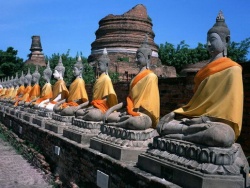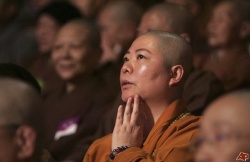Tien-Tai school
The Tien-Tai school was founded during the Suei dynasty (589-618). Tien-Tai means 'Celestial Terrace' and is the name of a famous monastic mountain (Fig. 1, Kwo-Chin-Temple) where this school's founder, Chih-I (538-597), spent the majority of his life teaching there.
This school is most famous for its profound interpretation of the Lotus Sutra (the main purpose of the sutra is to establish the one path, or vehicle, for attaining Buddhahood) and Chih-I's system of synthesizing the disparate teachings found in the Chinese Buddhist canon. Because this doctrine is based on the Lotus Sutra, it is also called the Lotus school.
Nagarjuna is regarded as the first patriarch of this school because his commentary works on Prajnaparamita Sutra (Treatise on the Transcendent Virtue of Great Wisdom. Chinese, Ta-Chih-Tu-Lun) stated "The wisdom which understands the principle of emptiness, the wisdom which understands the phenomenal differences and the Buddha wisdom (the three kinds of wisdom) are actually attained by one thought". This statement was further expanded by the second patriarch, Hui-Wen, and his student Hui-Sze (514-577), the third patriarch who was also Chih-I's teacher, which formed the early structure of the Three-views theory. This theory later became the root theory of Tien-Tai school but the completed philosophic system of the school was not fully established until Chih-I finished the commentary work on the Lotus Sutra.
This school takes as a premise that all phenomena are an expression of the true suchness (absoluteness) and this absoluteness is expressed in three phenomenon truths. One can only be fully enlightened by achieving the complete understanding of the three truths taught by the Buddha. These three phenomenon truths are:
- Dependent reality: A phenomenon is produced by various causes, its essence is devoid of any permanent existence.
- Phenomenal existence: This existence is temporary, and has its limitation.
- Middle: This truth of the middle is equated with true suchness, and it can not be found elsewhere than in phenomena. According to this truth, Dependent reality and Phenomenal existence are one.
And the only way to obtain the full awareness of the above truths is the Three views (or three insights):
- Emptiness: Phenomena posses no independent reality and they can not exist without other factors, therefore nothing is eternal.
- Unreality: Although a phenomenon has the apparent existence of phenomena and can be perceived by the senses, because its nature of emptiness, this phenomenon is temporary and unreal.
- Middle Way: Since a phenomenon is blended of emptiness and unreality, it is incorrect to view the truth in any of the above two poles. The proper action is to view a phenomenon and its parts as a whole, all phenomena are merged and contain one another.
The practice of this school consists of meditation based on the methods of Chih Kwan. The notion of Chih Kwan puts equal emphasis on the doctrinal and practical aspects which comprises the noble teachings that the Buddha proclaimed during his life. The Chih-Kuan practice contains:
- Chih (Samatha, Concentration): This is a technique to subdue those mental factors that fetter man to suffering so the further arising of illusions can be prevented.
- Kuan (Vipasyana, Contemplation): Through understanding of the three Phenomenon truths and Three views, enlightenment may be attained in a single spontaneous thought. "The whole world is contained in a mustard seed," and "Three Thousand Words in One Thought" are the famous Tien-Tai theories about how one thought embodies the universality of all things.
The principal works of this school are the " Tien-tai three big books" and " Tien-tai five small books". The Three Big Books are:
- The Profound Meaning of Lotus Sutra (Chinese, Fa-Hwa-Shuan-Ye): It uses the title of Lotus Sutra as the base to explore the true meaning of the Buddha's teaching.
- The Commentary of Lotus Sutra (Chinese, Fa-Hwa-Wen-Gui): It addresses the commentary of the contents of Lotus Sutra.
- Maha(Greater)-Samatha-Vipasyana (Chinese, Mou-Her-Chih-Kwan): It describes the right Chih-Kuan techniques to achieve the three virtues of nirvana, namely the true Dharma body (dharmakaya), wisdom of enlightenment, and liberation from suffering.
The Five Small Books are commentaries on five Mahayana sutras. These sutras are:
- The Commentary of the Visualization Of Buddha Amitayus Sutra
- The Profound Meaning of Golden-light Sutra
- The Commentary of Golden-light Sutra
- The Profound Meaning of Kuan-Yin Sutra
- The Commentary of Kuan-Yin Sutra
Other important teachings from Chih-I include Six Wondrous Gates of Liberation (Chinese, Liu-Miao-Fa-Men), Smaller-Samatha-Vipasyana (or Beginner's Samatha-Vipasyana), and Gradual Samatha-Vipasyana (or Explanation of the Gradual Dharma Door of the Dhyana Paramita. Chinese, She-Zen-Po-Luo-Mi).
The Tien-Tai school is generally considered a syncretistic school, because it synthesizes different viewpoints of other Buddhist schools from India. It represents an attempt to systematize the teachings of Buddha, to resolve different understanding of teachings arising within Buddhism of different doctrines, and to provide ways of solving metaphysical problems. In order to accomplish these objectives, Chih-I classified the teaching of Buddha into "five periods and eight teachings." It provides a place for the most widely different sutras and regards the Hinayana as well as the Mahayana as an authentic doctrinal expression of the Buddha.
The division of five periods is based on chronological criteria:
1. The period of the Avatamsaka-sutras
These sutras were taught by the Buddha immediately after attaining his enlightenment. It revealed the greatness of Buddhism that universe is the expression of the true suchness (absoluteness). The target audiences were the Budhisattvas though the teachings were too profound for most of the Buddha's general disciples to grasp. This phase lasted for twenty-one days.
2. The period of the Agamas-sutra
Because the Buddha's disciples did not understand the principal idea of the teaching during the first period, he then expounded the four noble truths, the eight-fold path, and the teaching of dependent-arising (pratitya-samutpada) as a means to develop the understanding of the truth. This teaching was Agamas and it lasted for twelve years.
3.The period of the Vaipulya-sutras
In this teaching the Buddha taught the introduction of the Mahayana, he stated the superiority of a Budhisattva over an Arhat, and the unity of Buddha and sentient beings, of absoluteness and relative. This phase lasted for eight years,
4.The period of the Prajnaparamita-sutra
The Buddha taught his disciples the meaning of emptiness in this period. Three of the central teachings on emptiness are the great, middle-length and shorter Prajnaparamita-sutra (Perfection of Wisdom Sutras). In all of these sutras, a complete explanation of both aspects of the path to Buddhahood, i.e. wisdom and method, was given. The fourth period lasted for twenty-two years.
5.The period of the Lotus Sutra and Mahaparinirvana-sutra
In the fifth and last period, which corresponds to the last eight years of Buddha's life, he emphasized the absolute identity of all opposites. The teachings during the last period expounded the ultimate and complete truth. It essentially concluded the previous four periods of teachings and stated that the three vehicles (triyana) of the Shravakas, Pratyeka-buddhas, and Bodhisattvas have only provisional validity and all of them will eventually merge into a single vehicle (ekayana) toward the Great Nirvana.
This represents a chronological division of the teaching. The school also holds the view that the Buddha taught the teachings of the five periods simultaneously. The reason why these teachings were viewed differently was because of the disciples' understanding and the methods that the Buddha was using. This leads to a systematization of the Buddha's teaching into eight doctrines: four of which are to be considered from the point of view of method and four from the point of view of content.
These eight teachings, even shown as different paths, are all capable of leading the practitioners to the final enlightenment. And the techniques of achieving nirvana are considered universal because it advocates the notion of universal liberation, which is possible because all beings and things possess Buddha-nature and because they all make use of available means for the realization of enlightenment.
The first group of the teachings is considered from the point of view of method, which includes:
- The Sudden method: Which is to be used with the most talented students who understand the truth directly. This is the method of the Avatamsaka sutra.
- The Gradual method: Which progresses from elementary to more complex doctrines and includes the Agama, Vaipulya-sutra, and Prajnaparamita-sutra periods. The Lotus Sutra is excluded.
- The Secret method: Which is to be used only when addressing individuals. The Buddha's teaching, in this case, was understood only by the selected disciples. Other disciples could have been present, but owing to the supernatural power of the Buddha, they would not have been aware of what he said to them individually.
- The Indeterminate method: In which, the individual disciples were attending the same session, they heard and understood the Buddha's words in different ways.
The last two methods were used by the Buddha when he wanted to instruct disciples of different capacities at the same time.
The second group of the teachings is considered from the point of view of content, which includes:
- The Hinayana teachings: It is meant for Shravakas and Pratyeka-buddhas.
- The Common teaching (common to the Hinayana and the Mahayana): It is meant for the Shravakas, Pratyeka-buddhas, and lower-level Bodhisattvas.
- The Special teaching: It is dedicated for the Bodhisattvas.
- The Complete (Round) teaching: The teaching of the Middle Way. Any teaching given by the Buddha should be considered as the ultimate teaching regardless of the methods.
The period of the Avatamsaka sutra included Special and Round teachings. The Agamas sutra was the only teaching of the Hinayana. The Vaipulya-sutras phase covered all four teachings. The Prajnaparamita sutra contained Round teaching but also covered Common and Special teachings. Only the Lotus sutra could be regarded as really the Round teaching.




